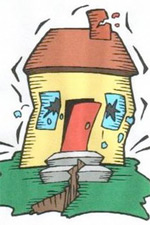I felt it – Earthquake in central Canada felt in Hartford County
So I’m tuned into a teleconference early this afternoon and I swear the room started to sway. Just a gentle rocking, but it was noticeable that I saw my monitor rocking a little. I actually wrote down “1:42 p.m. quake?” in my notebook. Wouldn’t you know there was a 5.5 quake in the northeast at 1:41 p.m. ET?
From the Globe and Mail.
A magnitude 5.5 earthquake hit central Canada this afternoon, rattling buildings from Windsor to Montreal and several U.S. states.
The epicentre of the quake was likely in Quebec, north of Ottawa, according to the U.S. Geological Survey, and struck at 1:41 p.m. EDT. The area – known as the Charlevoix-Kamouraska zone along the St. Lawrence River – is the most active seismic zone in Eastern Canada, according to a report for the Canadian Geological Survey published earlier this year. …
Twitter users as far away as Springfield, Mass. and Traverse City, Mich. reported feeling tremors. A Globe reporter in Montreal said that city also shook.
There were unconfirmed reports of minor injuries and damage. A Toronto Police spokesperson said that there have been no reports of injuries in Toronto, which was later confirmed by the city in a news release.
3 Comments

The website's content and articles were migrated to a new framework in October 2023. You may see [shortcodes in brackets] that do not make any sense. Please ignore that stuff. We may fix it at some point, but we do not have the time now.
You'll also note comments migrated over may have misplaced question marks and missing spaces. All comments were migrated, but trackbacks may not show.
The site is not broken.

its a weird feeling, I felt the one in the Hartford area back in 2002 or 2003… my 30 gallon marine fish tank was sloshing water all over the place, I was trying to keep the tank upright so that it would not make any more of a mess then it already had…. at first when it happened I thought I was crazy…. then WTIC 1080 reported the little quake… I was like AWESOME DUDE!
I didn't feel anything down on Main St, but I usually assume the building is shaking because of a passing bus or a hooptie with lots of bass.
From the Fema webste:
What to Do During an Earthquake
<!– START putting the Anchor link –><!– END putting the Anchor link –>
Stay as safe as possible during an earthquake. Be aware that some earthquakes are actually foreshocks and a larger earthquake might occur. Minimize your movements to a few steps to a nearby safe place and if you are indoors, stay there until the shaking has stopped and you are sure exiting is safe.
If indoors
DROP to the ground; take COVER by getting under a sturdy table or other piece of furniture; and HOLD ON until the shaking stops. If there isn’t a table or desk near you, cover your face and head with your arms and crouch in an inside corner of the building.
Stay away from glass, windows, outside doors and walls, and anything that could fall, such as lighting fixtures or furniture.
Stay in bed if you are there when the earthquake strikes. Hold on and protect your head with a pillow, unless you are under a heavy light fixture that could fall. In that case, move to the nearest safe place.
Use a doorway for shelter only if it is in close proximity to you and if you know it is a strongly supported, loadbearing doorway.
Stay inside until the shaking stops and it is safe to go outside. Research has shown that most injuries occur when people inside buildings attempt to move to a different location inside the building or try to leave.
Be aware that the electricity may go out or the sprinkler systems or fire alarms may turn on.
DO NOT use the elevators.
If outdoors
Stay there.
Move away from buildings, streetlights, and utility wires.
Once in the open, stay there until the shaking stops. The greatest danger exists directly outside buildings, at exits and alongside exterior walls. Many of the 120 fatalities from the 1933 Long Beach earthquake occurred when people ran outside of buildings only to be killed by falling debris from collapsing walls. Ground movement during an earthquake is seldom the direct cause of death or injury. Most earthquake-related casualties result from collapsing walls, flying glass, and falling objects.
If in a moving vehicle
Stop as quickly as safety permits and stay in the vehicle. Avoid stopping near or under buildings, trees, overpasses, and utility wires.
Proceed cautiously once the earthquake has stopped. Avoid roads, bridges, or ramps that might have been damaged by the earthquake.
If trapped under debris
Do not light a match.
Do not move about or kick up dust.
Cover your mouth with a handkerchief or clothing.
Tap on a pipe or wall so rescuers can locate you. Use a whistle if one is available. Shout only as a last resort. Shouting can cause you to inhale dangerous amounts of dust.